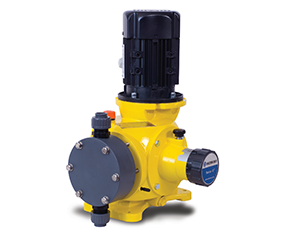According to the different structural forms of metering pumps, they can be divided into plunger metering pumps, diaphragm metering pumps, etc. The plunger metering pump consists of an adjustable diameter plunger and a pump body, which controls the flow rate of liquid by changing the movement distance and speed of the plunger. Diaphragm metering pump is a metering pump that uses a diaphragm as the working component to control the flow of liquid by changing the reciprocating motion of the diaphragm. According to different usage scenarios and requirements, different types of metering pumps can be selected for application.
One of the advantages of a metering pump is its accuracy. The metering pump can accurately adjust the flow rate as needed, achieving high metering accuracy and ensuring the stability of product quality. At the same time, the metering pump has good repeatability and can maintain stable flow during long-term operation. The metering pump also has high working reliability and stability. The metering pump adopts advanced structural design and manufacturing technology, ensuring the reliability and stability of the equipment. The pump body and working components have undergone special treatment, which has good wear resistance and corrosion resistance, and can adapt to various harsh working environments.
How to select and match the performance parameters of metering pumps introduced by metering pump manufacturers?
The selection of flow parameters for metering pumps is a very important task. Flow rate is the core performance indicator of a metering pump, which determines its conveying capacity. When selecting the flow parameters of the metering pump, it is necessary to first determine the flow requirements of the liquid to be transported. Determine a reasonable flow range based on the flow requirements, and then choose a metering pump with a flow slightly greater than that range. This is because there is a certain pump loss during the actual transportation process, which requires a certain amount of flow margin to compensate.
Secondly, the selection of pressure parameters for metering pumps is also very important. Pressure is the driving force behind the liquid conveyed by a metering pump, which determines the stability and effectiveness of the liquid conveyed by the metering pump. When selecting the pressure parameters of the metering pump, it is necessary to first determine the pressure requirements of the liquid to be transported, including inlet pressure and outlet pressure. Select the appropriate metering pump according to the pressure requirements, so that it operates within the appropriate pressure range, which not only meets the normal conveying requirements but also avoids equipment damage caused by excessive pressure.
In addition to flow rate and pressure, the accuracy parameters of the metering pump are also one of the factors that need to be considered. Accuracy refers to the accuracy of the liquid conveyed by the metering pump, which determines the measurement error during the conveying process. When selecting the accuracy parameters of the metering pump, it is necessary to first determine the measurement accuracy requirements of the liquid to be transported. Select a suitable metering pump according to the measurement accuracy requirements, ensuring that it has sufficient accuracy to meet the measurement requirements.
Electric metering pump refers to a liquid metering system that uses an electric motor to drive the movement of a piston or diaphragm. Its working principle is to control the reciprocating motion of the piston or diaphragm by controlling the start stop, forward and reverse rotation of the electric motor, thereby achieving liquid metering. Electric metering pumps usually have the characteristics of high metering accuracy and high degree of automation, and are suitable for situations with high metering requirements.
The structure of the metering pump is simple and convenient to use. A metering pump usually consists of a pump body, working components, control system, etc., with a compact structure and small space occupation. Easy to operate, flow regulation and monitoring can be easily achieved through the control system. The metering pump also has many other characteristics. For example, a metering pump can adapt to different working pressures and can adapt to different working environments by adjusting the pump's structure and material. The metering pump can also adapt to different media, including liquids, gases, and mixtures.
